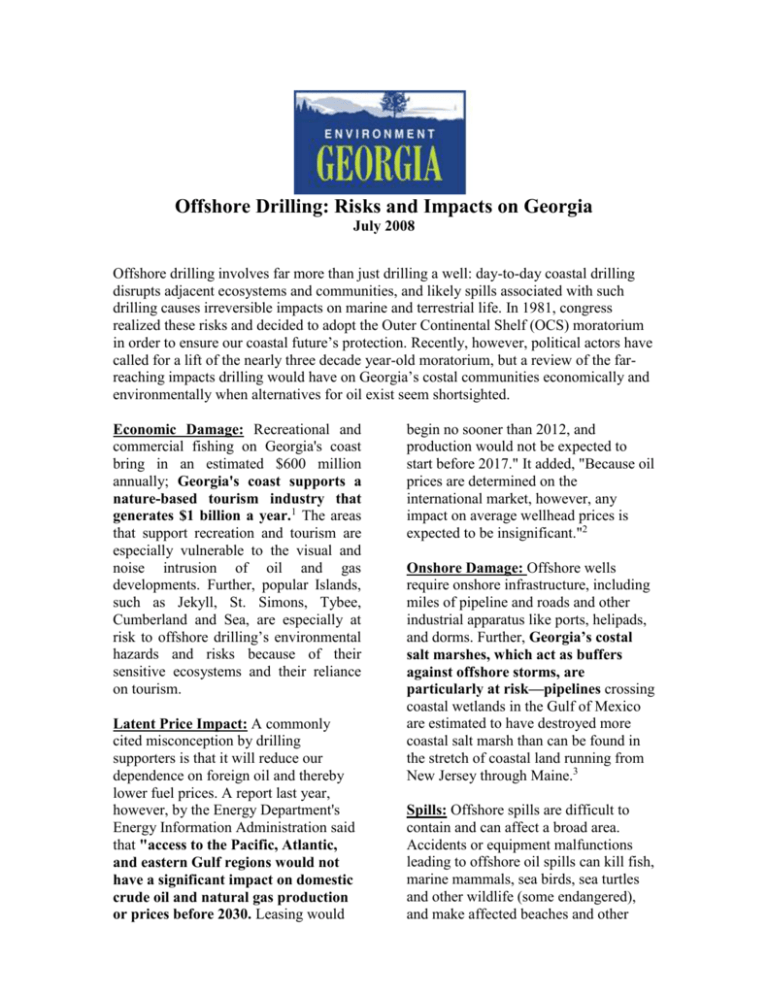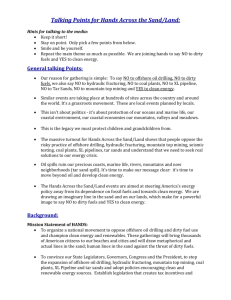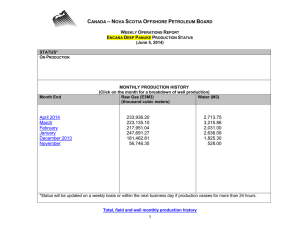Costal Drilling - Public Interest Network
advertisement

Offshore Drilling: Risks and Impacts on Georgia July 2008 Offshore drilling involves far more than just drilling a well: day-to-day coastal drilling disrupts adjacent ecosystems and communities, and likely spills associated with such drilling causes irreversible impacts on marine and terrestrial life. In 1981, congress realized these risks and decided to adopt the Outer Continental Shelf (OCS) moratorium in order to ensure our coastal future’s protection. Recently, however, political actors have called for a lift of the nearly three decade year-old moratorium, but a review of the farreaching impacts drilling would have on Georgia’s costal communities economically and environmentally when alternatives for oil exist seem shortsighted. Economic Damage: Recreational and commercial fishing on Georgia's coast bring in an estimated $600 million annually; Georgia's coast supports a nature-based tourism industry that generates $1 billion a year.1 The areas that support recreation and tourism are especially vulnerable to the visual and noise intrusion of oil and gas developments. Further, popular Islands, such as Jekyll, St. Simons, Tybee, Cumberland and Sea, are especially at risk to offshore drilling’s environmental hazards and risks because of their sensitive ecosystems and their reliance on tourism. Latent Price Impact: A commonly cited misconception by drilling supporters is that it will reduce our dependence on foreign oil and thereby lower fuel prices. A report last year, however, by the Energy Department's Energy Information Administration said that "access to the Pacific, Atlantic, and eastern Gulf regions would not have a significant impact on domestic crude oil and natural gas production or prices before 2030. Leasing would begin no sooner than 2012, and production would not be expected to start before 2017." It added, "Because oil prices are determined on the international market, however, any impact on average wellhead prices is expected to be insignificant."2 Onshore Damage: Offshore wells require onshore infrastructure, including miles of pipeline and roads and other industrial apparatus like ports, helipads, and dorms. Further, Georgia’s costal salt marshes, which act as buffers against offshore storms, are particularly at risk—pipelines crossing coastal wetlands in the Gulf of Mexico are estimated to have destroyed more coastal salt marsh than can be found in the stretch of coastal land running from New Jersey through Maine.3 Spills: Offshore spills are difficult to contain and can affect a broad area. Accidents or equipment malfunctions leading to offshore oil spills can kill fish, marine mammals, sea birds, sea turtles and other wildlife (some endangered), and make affected beaches and other natural habitat – including sensitive tidal marshes – severely polluted and unusable for extended periods. For any spill, only 5-15% can be cleaned up.4 From 1990 to 1999, offshore drilling platforms and pipelines spilled 1.8 million gallons of oil in U.S. waters.5 Hurricane Risk: Georgia is vulnerable to hurricanes that could destroy drilling infrastructure and induce toxic spills. The 2005 hurricane season highlights the danger of depending on susceptible offshore oil infrastructure, with Hurricanes Katrina and Rita destroying 113 petroleum production platforms in the Gulf of Mexico and damaging 457 pipelines connecting production facilities.6 Hurricanes Rita and Katrina also illustrate the risk of oil spills, spilling an estimated 508,000 gallons of oil in the Gulf of Mexico.7 Offshore Damage: During exploration and the construction of the well site and its associated infrastructure, there is potential for disturbance of ecological resources. Even when there are no large spills, the drilling and production process routinely releases hundreds of thousands of gallons of water and mud tainted with mercury, carcinogens and poisons into fragile ecosystems. Air Pollution: Offshore natural gas drilling contributes to air pollution. According to the National Oceanographic & Atmospheric Administration, each offshore oil platform generates approximately 214,000 pounds of air pollutants each year. An average exploration well for oil or natural gas generates 50 tons of nitrogen oxides, 13 tons of carbon monoxide, 6 tons of sulfur dioxide, and 5 tons of volatile organic hydrocarbons, contributing to smog, acid rain, and particulate pollution.8 History of Drilling 1947: Kerr-McGee completes the world's first commercial oil well 11 miles off Louisiana's shore, marking the beginning of our nation's offshore drilling industry. 1969: An offshore Union Oil Co. platform suffers a devastating blowout, leaking 200,000 gallons of oil into the clean waters of the Pacific Ocean. http://www.latimes.com 1981: Congress adopts the Outer Continental Shelf (OCS) moratorium, which protects America’s coasts, beaches and marine ecosystems from the threats of oil and gas development. Congress has since annually renewed the moratorium on new oil and gas development off the Atlantic and Pacific coasts as well as Bristol Bay Alaska. 2012: The presidential deferrals are set to expire. 1990: President George H.W. Bush authors an additional level of protection which defers new leasing until 2002. Other Options for our Coast 1998: Bill Clinton extends H.W. Bush’s additional level of protection. 2006: Oil and gas lobbyists try to pass a resolution urging for oil and gas exploration off the coast of Georgia. 2008: The Vitter amendment (#4207 to Senate Concurrent Resolution 70), which aims to end the OCS moratorium, is defeated. Two months later, the McConnell energy amendment of “drill anywhere and everywhere” is also defeated. The McConnell energy amendment’s proponents are 17 Republican senators, who have received $3 million total in campaign contributions from oil and gas industry affiliates, according to data compiled from the nonpartisan Center for Responsive Politics. In addition to the drilling provision proposal would open 2,000 acres of the Arctic National Wildlife Refuge in Alaska to oil and gas leasing and allow oil shale drilling in the West. Georgia’s Saxby Chambliss is a co-sponsor of this energy proposal. 9 2008: John McCain abandons his longtime support for a federal moratorium on drilling along the nation's coastlines in favor of allowing states to decide for themselves. 2008: President George W. Bush lifts a White House ban on offshore oil drilling and urges lawmakers to follow suit. Of renewable options, wind is off particular interest for costal Georgia. Wind power recently became a viable option for Georgia's coast, when researchers discovered a flaw in previous thinking regarding the winds off Tybee. Georgia's offshore wind capability was dismissed as inadequate when the federal Department of Energy scored it as a 2 on its seven-point wind scale in the 1980s; this rating, however, was mistakenly based on land values rather than correct offshore values. Today, winds are rated 4 and 5 on the same seven-point scale within 30 miles of the shoreline, and especially near Tybee, making wind a promising, clean energy for Georgia.10 References 1 Kyler, David, director of the Center for a Sustainable Coast on St. Simons Island “Don't risk GA coast in quest for energy,” Atlanta Journal Constitution Online Forum, July 5, 2005 2 Energy Information Administration, “Impacts of Increased Access to Oil and Natural Gas Resources in the Lower 48 Federal Outer Continental Shelf,” Internet accessed; available http://www.eia.doe.gov/oiaf/aeo/otheranalysis/on gr.html 3 Boesch and Rabalais, eds., “The Long-term Effects of Offshore Oil and Gas Development: An Assessment and a Research Strategy.” A Report to NOAA, National Marine Pollution Program Office at 13-11. 4 Donatoni, Matthew, “Offshore Drilling” http://cseserv.engr.scu.edu/StudentWebPages/M Donatoni/ResearchPaper.htm 5 National Research Council, Oil in the Sea III, 2003, p. 193, 195. 6 Sayre, Alan. "Agency: Katrina, Rita Destroyed 113 Petroleum Platforms." Associated Press 1 May 2006. <http://www.nola.com/newsflash/>. 7 U.S. Minerals Management Service. Estimated Petroleum Spillage from Facilities Associated with Federal Outer Continental Shelf (OCS) Oil and Gas Activities Resulting from Damages Caused by Hurricanes Rita and Katrina in 2005. 8 August 2006. 8 MMS, 2000. Gulf of Mexico OCS Oil and Gas Lease Sale 181, Draft Environmental Impact Statement (DEIS), p. IV-40 9 Mitchell, Kirsten B. “Bill Calls for Easing of Offshore-Drilling Restrictions.” Washington Bureau. 2008. <http://www.starnewsonline.com/article/200805 11/ARTICLE/792269660/1015/news0101&title= Bill_calls_for_easing_of_offshore_drilling_restri ctions>Internet; accessed 19 May 2008 10 Georgia Institute Of Technology, “Tech Study Finds Wind Feasible of GA Coast,” Internet Accessed; available at http://www.gatech.edu/newsroom/release.html?i d=1437







